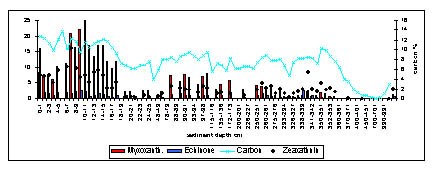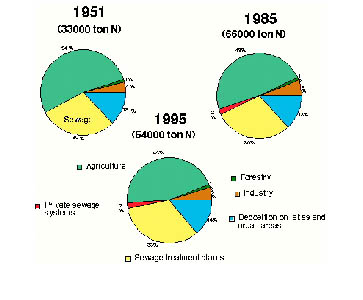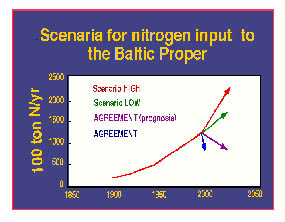
Edna Granéli
Marine Sciences Department
University of Kalmar
Sweden
Extended abstract
Harmful algal blooms (HABs) with disastrous consequences for the environment have increased in number, and in real distribution and biomass per unit water surface or volume during the last decades (see e.g. Granéli 1987, Anderson 1989, Lam & Ho 1989, Hallegraeff 1993). A well-documented case is the brackish-water, enclosed Baltic Sea. From long-term data it has been possible to corroborate the hypothesis that the increase in HABs has to a great extent been paralleled by an increased input of nitrogen and phosphorus to the Baltic Sea. Sediment cores from anoxic zones in the Baltic Sea show that some of the HAB species were already present 7000 years ago. However, it was only after 1963 that there was a dramatic increase in algal biomass (Poutanen and Nikkiilä 2001, Finni et al. 2001, Fig. 1).
This is most likely a direct consequence of the increased input of nutrients to the Baltic Sea after the 1940s, due to a rapid increase in the utilization of artificial agriculture fertilizers and increased discharge of untreated municipal sewage. Thus there was a delay of about 20 years before the increased input of nutrients, especially nitrogen, manifested itself as an increase in the biomass of harmful algae. In 1985 a decision was taken to decrease the loads of nitrogen to the levels of 1950. Thus, the nitrogen loading to the Baltic Sea for 1950 has been used as a threshold. Below this level of (nitrogen) loading it was considered that the recipient could adsorb and cope with the nutrient input without showing major adverse eutrophication effects, as e.g. HABs (Fig. 2).

Fig, 1. Pigments from cyanobacteria in the Gotland Deep (Baltic Sea) sediments and organic carbon (redrawn from Poutanen and Nikkilä 2001)
The Baltic Sea was probably not in a pristine state around 1950. However, it is difficult to compare present nutrient loading with even earlier periods, due to the lack of reliable nutrients analysis. When discussing eutrophication of the Baltic Sea system, total nutrient loading is of prime concern, involving the whole catchment area. It has been difficult to make accurate nutrient budgets for the Baltic Sea, due to lack of reliable data from some countries. However, total nitrogen loading on the Baltic proper is at least 1 000000 tons of nitrogen, of which 600 000 tons are discharged from land, 270 000 deposited directly on the sea surface and 130 000 tons are fixed by blue-green algae. The Baltic environment programme was created during the beginning of the 1990s (Granéli and Granéli 2001) to improve the Baltic Sea water quality. The intention is to create comprehensive programmes, with the objective of restoring the ecological balance of the Baltic Sea. Programme members are all countries within the Helsinki convention, the EU Commission, Norway, the Czech Republic, and several international banks. New in relation to e. g. Helcom is that priorities refer to the catchment area as an integrated unit, and that in principle the responsibility to realise the programme is collective. It is estimated that this ambitious programme will take at least 20 years to realise and that costs will be in the order of 20 billion ECU. To meet the principal objectives of the Baltic Environment Programme, large-scale efforts are being implemented with the aim of reducing nitrogen in sewage, nitrogen leakage from agriculture and to increase the retention of nitrogen leached from terrestrial ecosystems. Among the measures being taken can be mentioned the construction of sewage treatment facilities for denitrification, the creation of wetlands, the restoration of streams with buffer strips, better storage facilities for manure and changes in fertiliser applications and crop rotation (Fleischer et al. 1987, Jansson et al. 1994, Anon. 1997). The goal of a 50 % reduction has, however, not yet(1998) been achieved, neither in Sweden, nor in other western European countries. Only in the Baltic republics have emissions been reduced, but this is more an effect from regression in the agricultural and industrial sector than from construction of, for instance, sewage treatment facilities. It can also be questioned whether 50 % reduction will be sufficient. If this target is reached for all countries contributing to the nutrient loading of the Baltic, nitrogen loading would be back at roughly the 1950 level. Still, this would mean a nitrogen loading at least double the “natural”. In 1950 there were already signs of eutrophication in the Baltic.
The reality and scenarios for the future
Eutrophication symptoms, e. g. blooms of algae, some of them toxic, seem to be increasing, not decreasing, in many Swedish coastal areas and in the Baltic Sea as a whole, in spite of efforts to control nitrogen (and phosphorus). The reason may either be that nitrogen loading does not control algal growth, or – perhaps more likely - that the system reacts slowly due to large internal stores of nutrients and a long residence time (>20 years). In addition, even if nutrient loading to Swedish coastal areas has decreased, nutrient loading to the Baltic Sea as a whole has not decreased, and may even be increasing. The Helcom goal of a 50 % reduction in (anthropogenic) nitrogen loading between 1985 and 1995 is far from being fulfilled and this also is true for the EU goal of a 30 % reduction in nitrous oxide emissions. What is then the prospect for the future with respect to implementation of nutrient reduction and what will happen to the Baltic?
For such a large, hydrodynamically complicated and horizontally non-uniform system, it is difficult to make any reliable prognosis with respect to biological conditions, even if we knew more precisely what changes in nutrient loading could be expected. A reduction in nutrient input according to agreements, i. e., until ca 1995, has already proved impossible. It is now thought that a more realistic time horizon for these goals to be reached is 20-25 years, which means around 2020. What will then happen to nutrient concentrations in the Baltic can be predicted with some confidence, while the biological consequences are less certain. According to model calculations (Wulff and Stigebrandt 1989, Persson 1993), phosphorus concentrations will decrease to the levels that existed at the end of the 1970s, while nitrogen concentrations will reach 75 % of present levels (Fig. 3). Although these may seem modest improvements, a positive trend towards better conditions (Tab. 1), however small, in the Baltic would be a tremendous boost for further actions and for co-operation between the countries around the Baltic Sea.
Are inorganic nutrients the sole thresholds for HAB occurrences?
As mentioned in the previous paragraph, the blooms of HABs in the Baltic are
not decreasing, but increasing, in spite of the countermeasures taken to reduce
N and P. For example blooms of the dinoflagellate Heterocapsa triquetra , colouring
many coastal embayments/fjords along the Baltic Sea during the month of June,
have increased during the last 30 years (Larsson et al 2001).
Besides the resilience of the ecosystem with respect to inorganic nutrients,
other factors may be involved in the continuation or even increase in HABs.
One of those is organic nitrogen bound to humic material, which can directly
or indirectly stimulate phytoplankton growth (Carlsson & Granéli
1993), especially HABs within the group of dinoflagellates and flagellates (Granéli
et al 1985, Granéli & Moreira 1990; Carlsson et al. 1998). However,
other phytoplankton species can also utilize humic material as e. g. Nodularia
spumigena, a toxic cyanobacterium species responsible for blooms covering a
major part of the Baltic Sea proper during late summer, is able to utilize phosphorus
from humic compounds to increase its nitrogen fixation (Panosso et al.). The
loading of river-transported, high molecular weight dissolved organic matter
(humic and fulvic acids) to coastal waters can contain a major proportion of
the total nutrient input. For the Baltic Sea for example, organic nitrogen bound
to riverine humic material may contribute 50% of the total nitrogen being discharged
(Wulff et al. 1996).
 |
 |
| Fig. 2. Calculated anthropogenic nutrient loading on the Skagerrak, Kattegat and Baltic proper from Sweden 1951, 1985 and 1995 (redrawn from Anon. 1997). | Fig.3. Scenario for nitrogen input to the Baltic proper (redrawn from Persson 1993 |
| Agreement (-50% N) | Low (+50% N) | High (+100% N) | |
| Transparency change (m) | +2.5 | -0.7 | -1.0 |
| Algal Biomass (future/today) | 0.5 | 1.5 | 2.0 |
Table: Prognosis for the development of the Baltic proper ˜1995-2020 (from Persson 1993).
Humic colouring of fresh water systems (lakes, rivers) in the Southern part of Sweden has been steadily increasing. For example, Romare and Cronberg (2001) reported that in Lake Bolmen (Sv Sweden), water color (˜organic matter content) from 1966 to 2000 increased from 20 to 60 mg Pt/l (platinum), and in some of the lake’s already very humic tributaries it doubled (e. g. from 150 to 300). The same trend is found for the tributaries of Lake Vättern, the second largest lake in Sweden. Between 1970 and 2000, organic carbon content increased by 50% (Lindell 2003) in tributaries. Many of these humic waters ultimately discharge into the Baltic Sea. An increase in the input of humic substances to the Baltic Sea was in fact noted already during the 1980-ies (Andersson et al 1991).
To decrease HABs and improve water quality in the Baltic Sea a threshold based mainly on the loading of inorganic N and P has been discussed. In those values organic nitrogen or phosphorus were thus not included, and until recently there was only scanty knowledge on the availability of organically bound nutrients for HAB growth. Even now we are far from understanding what nutrients in e. g. humic matter represents for HAB biomass production in the Baltic Sea. One thing we can be rather confident about is that if there has been an increase in the number and severity of HABs over, say, the last 50 years (for which there are strong indications), it is safe to assume that the increase has to do with human activity. This may be due to direct pollution, but also indirectly through e.g. the greenhouse effect causing increased leakage of humic matter. Disruption of the pelagic food chain due e. g. to selective fishing or overfishing, also a consequence of human activity, may also promote HABs. Thus not only loading of inorganic nutrients, but also organic matter loadings and fishing activities should be subjected to thresholds to manage algal blooms.
ACKNOWLEDGEMENTS
This work was financed by the European Commission (Research Directorate General-Environment Programme - Marine Ecosystems), through the FATE project “Transfer and Fate of Harmful Algal Bloom (HAB) Toxins in European Marine Waters” (contract no EVK3-2001-00050). The FATE project is part of the EC EUROHAB cluster
REFERENCES
Anderson D.M. 1989. Toxic algal blooms and red tides : a global
perspective, In Okaichi, Anderson D. M. & Nemoto (eds.), "Red Tides
: Biology, Environmental Science, and Toxicology". Elsevier Sci. Publ.,
New York, pp. 11-16.
Andersson T, Nilsson Å, Jansson M (1991) Coloured substances in Swedish
lakes and rivers - temporal variation and regulating factors. In: Allard (ed)
Humic substances in the aquatic and terrestrial environment. Springer-Verlag,
Berlin Heidelberg: 243-253
Anonymous. 1997. Nitrogen from land to sea. The Swedish Environmental Protection
Agency, Naturvårdsverket Förlag, Rep. 4735: 113 p. (In Swedish).
Carlsson P, Edling H, Béchemin C (1998) Interactions between a marine
dinoflagellate (Alexandrium catenella) and a bacterial community utilizing riverine
humic substances. Aquat Microb Ecol 16: 65-80
Carlsson P, Granéli E (1993) Availability of humic bound nitrogen for
coastal phytoplankton. Estuar Coast Shelf Sci 36: 433-447
Finni T, Kononen K, Olsonen R Wallström K (2001) The history of cyanobacterial
blooms in the Baltic Sea. AMBIO 30:172-178.
Fleischer, S., Hamrin, S., Kindt, T., Rydberg, L. Stibe, L. 1987. Coastal eutrophication
in Sweden: reducing nitrogen in land runoff. – Ambio 16:246-251.
Granéli, E. Moreira, M.O., 1990. Effects of river water of different
origin on the growth of marine dinoflagellates and diatoms in laboratory cultures.
J. Exp. Mar. Biol. Ecol., 136: 89-106.
Granéli, E. Granéli, W., 1999. Reducing nitrogen transport to
Swedish costal waters - a case study. In: Cronaert, M, and Lipiatou, E..(Eds.)
Marine research and policy interface. Links, interdiciplinary cooperation, availability
of results and case studies. Third European marine science and technologiy conference,
Luxembourg 1999. pp. 21-34
Granéli E, Edler L, Gedziorowska D, Nyman U (1985) Influence of humic
and fulvic acids on Prorocentrum minimum (Pav.) J. Schiller. In: Anderson DM,
White AW, Baden DG (Eds.). Toxic Dinoflagellates, Elsevier Science Publishing
Co., Inc., North-Holland: 201-206
Granéli E, Moreira, MO (1990) Effects of river water of different origin
on the growth of marine dinoflagellates and diatoms in laboratory cultures.
J Exp Mar Biol Ecol: 136: 89-106
Granéli E. 1987. Dinoflagellate blooms. Occurrence, causes and consequences
in the marine environment- A review. ISBN 91-620-3293-3, SNV report 3293 133
pp. (in Swedish).
Hallegraeff G. 1993. A review of harmful algal blooms and their apparent global
increase. Phycologia 32: 79-99.
Jansson, M., Andersson, R., Berggren, H. Leonardsson, L. 1994. Wetlands and
lakes as nitrogen traps. – Ambio 23:320-325.
Lam C.W.Y., Ho K.C. 1989. Red Tides in Tolo Harbour, Hong Kong. In: Red Tides.
Eds. Okaichi T., Anderson D.M. Nemoto T. Elsevier. 49-52.
Larsson U., Hajdu S., Andersson L., Edler E., Sundelin B., Eriksson A.K., 2001.
Surface waters an phytoplankton., Österjö’98, pp. 27-32. (In
Swedish).
Lindell, M. (ed.). 2003. Vätternvårdsförbundet – Årsskrift
2002. – Vättenvårdsförbundet Report 69, 89 pp.
Panosso, R., Granéli, E., 2000. Effects of dissolved organic matter on
the growth of Nodularia spumigena (Cyanophyceae) cultivated under N and P deficiency.
Marine Biology. 136:331-336
Persson G. 1993. Eutrophication. - In: Anon. 1993. The environmental situation
in Sweden 2020, Swedish Environmental Protection Agency Report 4104, p 50-61.
Naturvårdsverket Förlag (in Swedish).
Poutanen E-L, Nikkiilä K 2001 Carotenoid pigments as tracers of cyanobacterial
blooms in recent and post-glacial sediments of the Baltic Sea. AMBIO 30:179-183.
Romare, P. , Cronberg, G. 2001. Bolmen – Resultat från limnologiska
undersökningar under åren 1995-2000 med en sammanfattning av resultaten
från åren 1966-2000. – Limnologiska avd, Lunds universitet,
Wulff F, Perttilä M, Rahm L, 1996 Monitoring, mass balance calculation
of nutrients and the future of the Gulf of Bothnia. AMBIO 8: 28-35
Wulff, T, Stigebrandt, A. 1989. A time-dependent budget model for nutrients
in the Baltic Sea. Global Biog.Cycles 3:53-78.